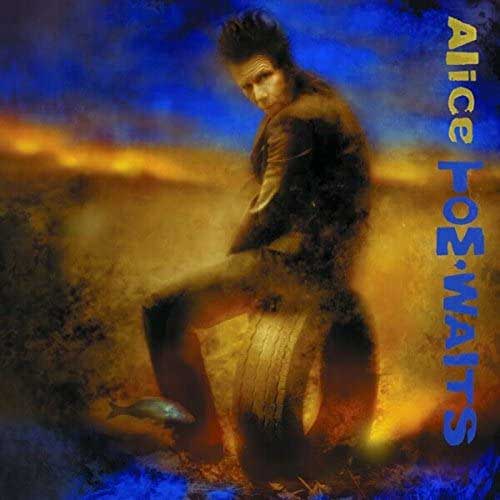
Music – films – theatre – books fall under gaze of Alan Dearling
Tom Waits/Kathleen Brennan – ‘Alice’ studio recording 2002 (has recently been re-released on vinyl) in October 2022
This is an imaginative, multi-layered work that was recreated by Waits and Brennan from the remains, almost the wreckage, of the demos from the 1992 ‘Alice’ stage musical that had previously been bootlegged. They were probably stolen from Waits’ car. The studio album contains very different versions of some of the songs written for the ‘Alice’ theatrical performance. According to Wikipedia: “The adaptation was directed by Robert Wilson, whom Waits had previously worked with on the play The Black Rider, and originally set up at the Thalia Theatre in Hamburg in 1992.”
The 2002 studio album, ‘Alice’ was co-released on the same day with ‘Blood Money’, an album containing songs from Wilson and Waits’ 2000 musical ‘Woyzeck’
For the 20th anniversary release, Waits’ ‘Alice’ is now available on a new double vinyl version in October 2022. Much of its content is more orchestrated and polished than the visceral stripped-down theatrical versions, which also included ten instrumental pieces. But it is still edgy, guttural and world-weary. Tom at his gargling-in-the basement mode. The album is very much about the Reverend Dodgson who seems to have had rather secular longings for Alice Liddell. Tom Waits sings:
“All I can think of is Alice.
And so, a secret kiss becomes madness as well as bliss.”

The songs are filled with sadness and grief, evoking the German underbelly of the Hamburg Reeperbahn. Madness and insanity deep in the bowels of the burlesque. ‘I must not be late’, Waits’ intones on the slightly mangled, quasi-Germanic song, ‘Kommienezuspadt’ (apparently translates as: “Komme nie zu spät” means “never be late”.) An echo of the Rabbit in ‘Alice in Wonderland’ one assumes.
I very m uch agree with this reviewer on Amazon.
D.W. Glenn: “5.0 out of 5 stars Weird Surreal and Brilliant!
Sit back and enjoy the gravel voiced opium ride of exploring the nether regions of TW’s mind. Surreal and weird is just for starters. It’s also written with the quirky profound wry insights of life that only he is capable of. I was hooked on the second listen.”
Fascinating documentary footage from the 1992 Thalia Theatre Hamburg ‘Alice’:
https://www.youtube.com/watch?v=z5DsqaaJ9eA
The ‘Alice’ track linked to a film. Surreal indeed. Attributed to: @joshuasteward939
https://www.youtube.com/watch?v=x9DejWMJoOA

“The footage used here is excerpts from ‘Le Ballet Mécanique’, an Austrian experimental short film from 1924, directed by Fernand Léger. The woman most often seen is Alice Prin (or “Kiki of Montparnasse”), a well-known French artist’s model, nightclub singer, actress, painter, and general muse for many famous artists and writers. She was born in Côte d’Or in 1901 and died in Montparnasse in 1953 at the age of 51. According to Wikipedia, her tomb identifies her as ‘Kiki, 1901–1953, singer, actress, painter, Queen of Montparnasse.’ “
Meanwhile, if you can find the 1992 ‘Alice demos’ album you are in for an even darker, dark treat. It’s nasty, dirty, filled with creaking sounds of harmonium and strangely contorted, specially created instruments. A distorted world, a slice of cabaret that takes Lewis Carroll into an off-kilter, extraordinarily intense musical experience. Funereal, disjointed music, half-way between Jewish-German carnival and the Gollum filled with hysteria and suicide. Tom Waits at his hysterical, bleakest, a circus-barker, who is yet, also “hanging in a bottle” in a lunatic asylum.
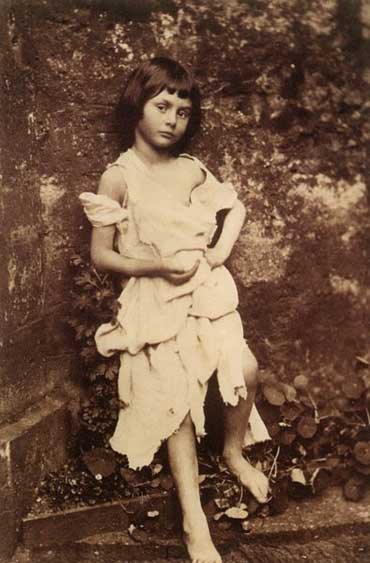
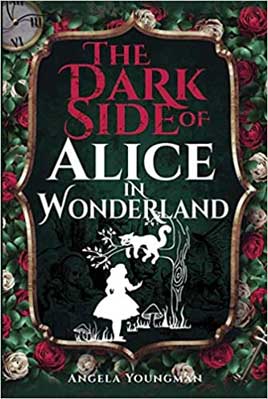
‘Alice’ is an allegory on the loss of childhood innocence, but it’s also a discussion of discordance in the Reverend Dodgson’s infatuation with young girls and especially, Alice Liddell – was he there to help or harm them? Or, perhaps both? The Rev was rightly renowned for his Alice books, but his photography offers a worrisome Pandora’s Box. The photo of Alice is one he took in 1858. The photography-news site informs us that Lewis Carrroll took photos for 24 years and had his own studio: “From the 3000+ photographs taken by Dodgson, only 1000 have survived due to the passage of time and deliberate destruction, of which just over half are of children (mostly young girls) – 30 of whom are depicted nude or semi-nude.”
There are a number of books featuring Lewis Carroll’s photos, and on-line, including at Wiki-art: https://www.wikiart.org/en/lewis-carroll
And books, such as Angela Youngman’s, that attempt to uncover/unravel the murkier side of Lewis Carroll’s life and ‘worlds’.
John Lennon – the influence of Lewis Carroll on his writings/lyrics
John Lennon frequently claimed that he was a great fan of Lewis Carroll’s writings in the two Alice books and Jabberwocky. Here’s an example for the interview Playboy magazine published soon after John’s death:
PLAYBOY: “Where did ‘Lucy in the Sky’ come from?”
LENNON: “My son Julian came in one day with a picture he painted about a school friend of his named Lucy. He had sketched in some stars in the sky and called it ‘Lucy in the Sky with Diamonds,’ Simple.”
PLAYBOY: “The other images in the song weren’t drug-inspired?”
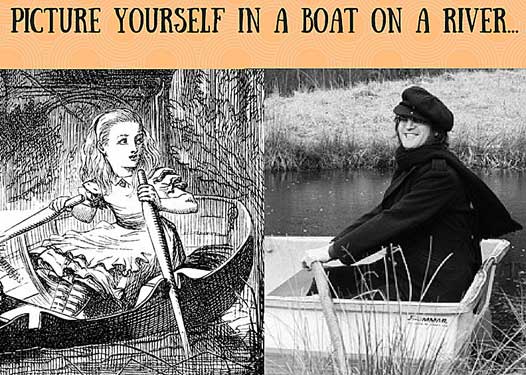
LENNON: “The images were from ‘Alice in Wonderland.’ It was Alice in the boat. She is buying an egg and it turns into Humpty Dumpty. The woman serving in the shop turns into a sheep and the next minute they are rowing in a rowing boat somewhere and I was visualizing that. There was also the image of the female who would someday come save me… a ‘girl with kaleidoscope eyes’ who would come out of the sky. It turned out to be Yoko, though I hadn’t met Yoko yet. So maybe it should be ‘Yoko in the Sky with Diamonds.’ ”
‘I am the Walrus’ was also a nod towards the ‘Walrus and the Carpenter’ poem by Lewis Carroll, though Lennon later claimed that he had mistaken the Walrus as the ‘good guy’, but perhaps both characters are somewhat ‘bad’ or ‘edgy’.
Grace Slick – White Rabbit
Fab re-mastered video for the song, ‘White Rabbit’: https://www.facebook.com/watch/?v=225369579549203
“Feed you head” indeed!
I remember buying both the two Great Society albums on vinyl. They were rough live albums compared with the more rounded sound of the Jefferson Airplane, who Grace Slick joined after Signe Anderson, the original female singer with the Airplane left. Here are excerpts from Arun Starkey in ‘Far Out!’ (2021) magazine writing about the creation of ‘White Rabbit’:
“It was Jefferson Airplane front-woman and all-around heroine Grace Slick who composed the tune. However, it was not originally written for the iconic psychedelic rock troupe; instead, her previous band, the San Francisco rockers the Great Society. It was actually first performed by the Great Society in early 1966 at a dive bar on Broadway in San Francisco.
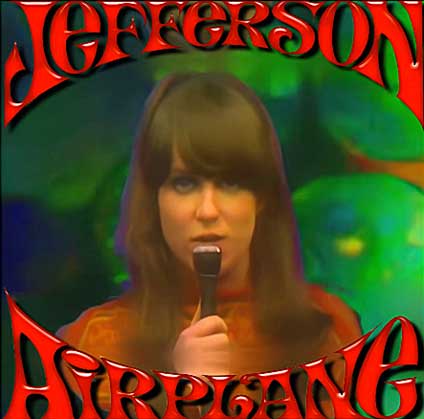
At the time of writing in late 1965 or early ’66 (the precise date is unknown), LSD was still legal, as the darkness it brought was still yet to be truly uncovered…
Given that LSD was in the ascendancy, as was the hippie movement in general, with San Francisco being its epicentre, this all fed into the song’s inception. In addition to Slick being somewhat of an eccentric, this went some way in informing the song’s trippy feel. This wasn’t all, though, as there are numerous references to Lewis Carroll’s Alice in Wonderland and its sequel, Through the Looking Glass.
There are many memorable direct nods to Carroll’s narcotic wonderland as Slick mentions Alice, the White Rabbit, the hookah-smoking caterpillar, the White Knight, the Red Queen, and the Dormouse. She also mentions changing size after taking pills or drinking an unknown liquid. This genius inclusion of Carroll’s creations augments the song by having lyrics that are intrinsically fantastical, helping listeners to escape the mundanity of life. She has even said that her interpretation of the titular rabbit is representative of “your curiosity”, an apt narrative for the era that was totally defined by experimentation and mind expansion, railing against the established social mores.
Massively inspired by an LSD trip, and Lewis Carroll, Slick wrote the lyrics first and then she created the melody on a red upright piano she had recently purchased for $50, where over ten of the keys were missing. She would later say that “was OK because I could hear in my head the notes that weren’t there”, a brilliant adaptation to her circumstances.”
Jonathan Miller – Alice in Wonderland (BBC play/film 1966)
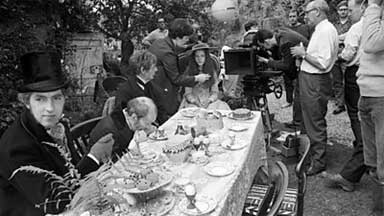
An adult-oriented take on Alice, made just as the Beatles were releasing ‘Revolver’ and recording ‘Sergeant Pepper’. A TV play in black and white created on film. Jam-filled with a host of celebrities and ‘stars’ including Peter Sellers, Malcolm Muggeridge , Peter Cook (who is eccentrically good), John Bird, Michael Redgrave and John Gielgud. Plus, the unknown Anne-Marie Mallik as Alice. Chosen apparently because she looked ‘Victorian’. Throughout, she remains enigmatic, wistfully drifting along, seemingly bored and aloof to proceedings. Meanwhile, Ravi Shankar’s sitar and table Indian music was used to create a British Empire Raj feel into this really rather strange ‘take’ on ‘Alice’. It’s surreal in a very trippy post-Goons’ way. The actors are not in animal costumes, yet it is in many ways one of the most oddball and disquieting of all the film adaptations. It’s disorientating, redolent of the word play of the Alice books, full of riddles and ‘jokes’: ‘Beating time’; The tortoise ‘taught us’, ‘lessons’ start to ‘lessen’ over time. Certainly vastly more interesting than the Disney film cartoon and their two more recent Tim Burton films featuring over-blown performances from Johnny Depp and Helena Bonham-Carter.

From the British Film Institute notes on line:
Michael Brooke:
“Miller is careful not to create a clichéd ‘dreamlike’ ambience – he respects the logic of Dodgson the mathematician as well as the fantasies of Carroll the dreamer, and plays everything straight, photographed in crisp, deep-focus black-and-white by regular Ken Russell collaborator Dick Bush. Of all Carroll adaptations, only Jan Svankmajer’s partly animated ‘Alice’ (Neco z Alenky, Czechoslovakia, 1987) is as faithful to the spirit as well as the letter of the original.”
The film ‘twinkles’ with a capital ‘T’! Imaginative and very of its 1960s’ time. A time of ‘Yellow Submarine’ and the ‘Magical Mystery Tour’. As Alice muses at the end of her dream, “The things I’ve seen, I can see no more”.
On-line film link: https://archive.org/details/alice-in-wonderland-1966-jonathan-miller
Jan Svankmajer – Alice (Czech, 1988)
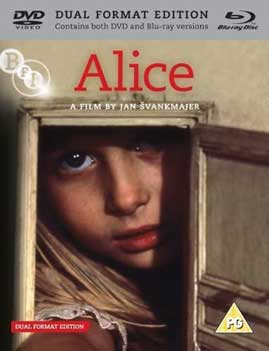
As a futurist animator, Jan is frequently referred to as the biggest inspiration on Terry Gilliam. His works are renowned for their mix of models, puppets and real-life actors – they are ‘darkness’ personified and creep with the tension of a good horror film! In fact, at the beginning of the film, Jan’s Alice tells the audience, “This is made for children – perhaps!”
She adds, in a nod towards the ‘wonderment’ of re-imagination that abounds in this macabre film version, “You must close your eyes, or, you will see nothing.”
A malicious, sadistic, White Rabbit is the guide for Alice. It’s a stuffed rabbit that leaks sawdust and sews up its own wounds whilst surrounded by the relics of the taxidermist’s art. Drinking ink, nibbling tarts and little pieces of a wooden mushroom, Alice moves from scene to scene, alternating in size, as a wide-eyed un-afraid young human girl and a small and big, Alice-like doll.
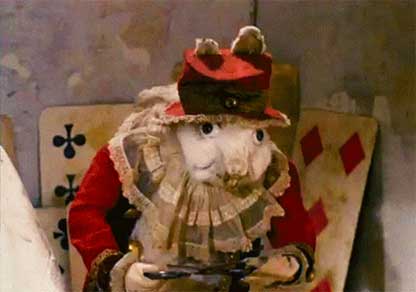
It’s deeply disturbing, a Punch and Judy version, surreal and visually stunning especially in blu-ray. It moves into new and different scenarios from the Lewis Carroll’s books.
Here is an on-line link to this Czech film: https://www.youtube.com/watch?v=Bnbd1exbIco
If you haven’t seen Jan Svankmajer’s creations, and think this might be for you, go check him out. With some difficulty, I now own a US-format of many of his earliest ‘shorts’, including ‘The Ossuary’ from 1970 – a monochrome ‘trip’ on a school visit into the world’s freakiest mausoleum, an art-work underground in the Sedlec Chapel, crammed with skeletons and bones from 70,000 people, dead from wars, plagues and torture. The on-line Youtube version isn’t the high definition experience, but it is still unnerving.
https://www.youtube.com/watch? v=UnLNeqSf8hU
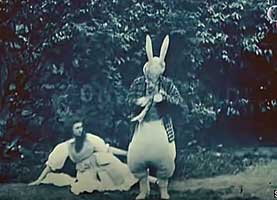
The earliest film version of ‘Alice’ is 800 feet of celluloid: obviously in monochrome but with some film tints, murky, ethereal and weird… Alice in Wonderland in 1903, directed by Cecil Hepworth and Percy Stow. Only about 8 minutes of the original are now available of the original 12 minutes, thanks to the British Film Institute. I have my own copy from the BFI, and discovered it to be rather wonderful and fantasy-filled for such an early experiment with special effects, including the shrinking and expansion of Alice. The blu-ray is a great quality rendering of the original.
https://www.youtube.com/watch?v=zeIXfdogJbA
Dennis Potter-Gavin Millar – Dreamchild (1985)
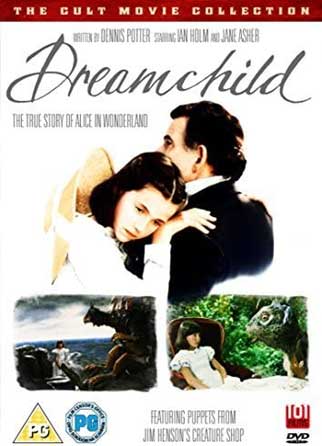
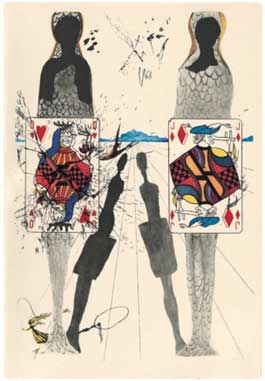
I’ve chosen ‘Dreamchild’ as my final destination in this really rather oddball, surrealist roll-call of tales about Lewis Carroll, his life, works, films, music and ‘Alice’. The Alice who has inspired so many other creators including artists, John Tenniel to Salvador Dali and Ralph Steadman, along with those already mentioned.
Having recently bought a copy and watched it again, ‘Dreamchild’, remains a remarkable piece of relatively low budget film, which sank almost without trace in cinemas. The stuttering, rather shy portrayal of Lewis Carroll by Ian Holm is believable, as is the show-stealing, Coral Browne as an octogenarian Alice – Mrs Alice Hargreaves – on a PR tour of America. As Dodgson/Carroll remarks, it is an ‘imagined landscape’. One that is, in particular, a creation of Dennis Potter’s extremely fertile imagination along with Gavin Millar as director. It’s a fairly softly romanticised, emotional story of forbidden love and longing. We also get to see the inimitable Ken Campbell on screen (and voicing the March Hare), a brief interlude with Jane Asher as Mrs Liddell, and a selection of Jim Henson’s puppets in the character-roles from the Alice books. It’s definitely more fiction than fact, but very watchable.
Here’s an on-line link to the video: https://www.youtube.com/watch?v=wwnoJ-WSEEY
